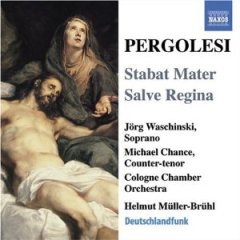Giovanni Battista Pergolesi – Stabat Mater; Salve Regina (Brühl) [2006]
Giovanni Battista Pergolesi – Stabat Mater; Salve Regina (Brühl) [2006]

01. No. 1, "Stabat Mater"
02. No. 2, "Cuius animam"
03. No. 3, "O quam tristis"
04. No. 4, "Quae moerebat"
05. No. 5, "Quis est homo"
06. No. 6, "Vidit suum dulcem Natum"
07. No. 7, "Eia Mater"
08. No. 8, "Fac ut ardeat"
09. No. 9, "Sancta Mater"
10. No. 10, "Fac ut portem"
11. No. 11, "Inflammatus et accensus"
12. No. 12,"Quando Corpus morietur"/No. 13, "Amen"
13. No. 1, Salve Regina
14. No. 2, Ad te clamamus
15. No. 3, Eja ergo
16. No. 4, Et Jesum
17. No. 5, O clemens
Jörg Waschinski - soprano Michael Chance – countertenor Cologne chamber Orchestra Helmut Müller-Brühl – conductor
The Pergolesi setting was written in about 1735 and was first printed in London in 1749. It became the most frequently published single work of the 18th century. The Stabat Mater and Salve Regina were composed it at the end of his life which was spent at a Franciscan monastery in Pozzuoli, trying unsuccessfully to stengthen his weak constitution. It was commissioned by the Confraternita dei Cavalieri di San Luigi di Palazzo and was intended for use by the Brotherhood as music for Good Friday, to replace the Stabat Mater by Allesandro Scarlatti, which by then was rather old fashioned. Pergolesi died on 16th March 1736 aged just 26.
The text is based upon the prophecy of Simeon that a sword was to pierce the heart of Christ's mother Mary (Luke 2: 35). The concept of 'God' in Christianity is male, yet in the Stabat Mater and one other great religious text, the Magnificat, we find a unique feminine perspective.
This recording by Naxos completes a circle. Earlier recording feature female soprano and alto often in operatic renditions of this piece. Later we had female soprano and male alto (countertenor) in more subdued renditions. This new version features the British Counter Tenor Michael Chance and the German male Soprano (or Sopranist)Jorg Waschinski. What we therefore get is closer to the orginal performance and sound of Pergolesi's times. It is a fine, clear recording with wonderful singing, particularly in the Salve Regina. Some will miss the richness of earlier recordings but this is a real find not to be missed. ---Phillip Tolley
Last Updated (Sunday, 24 March 2013 17:47)








